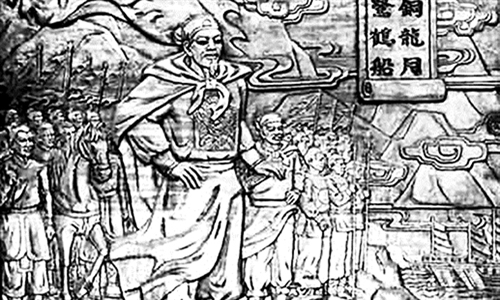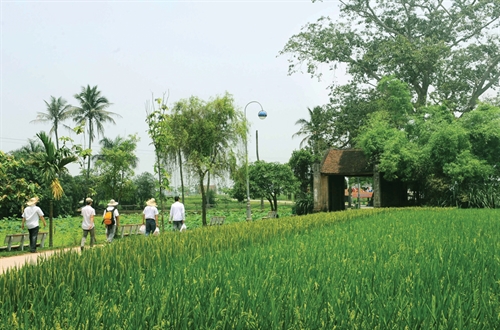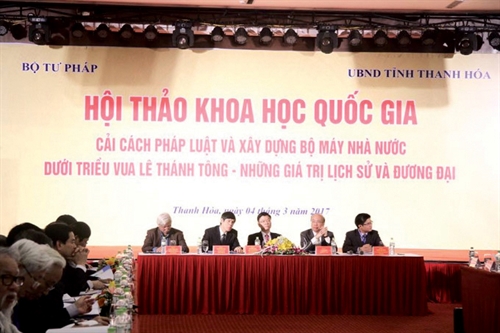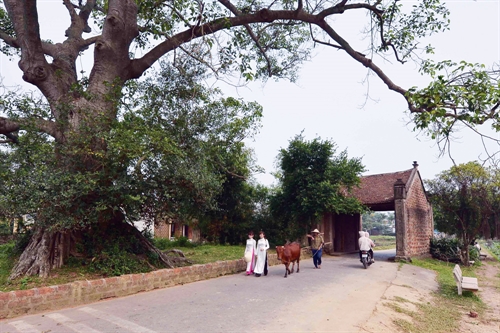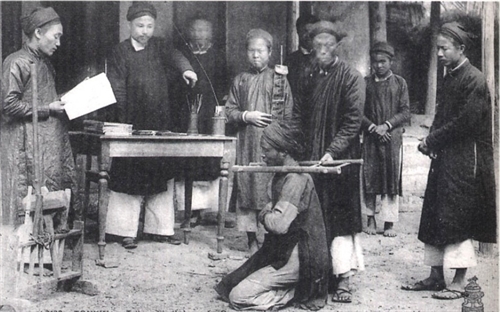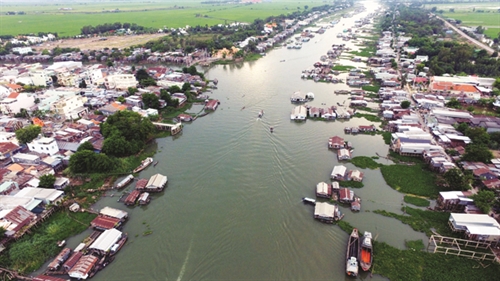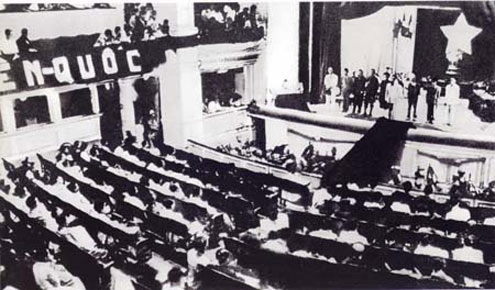Lawyer Tran Thi Tuyet
The State and Law Institute
In August 1945, a great revolution broke out in Vietnam, smashing the French colonialists’ 80-year rule, overthrowing the thousands-year old feudal regime, regaining the power for the people and setting up a state of new type, the state of the Democratic Republic of Vietnam.
The first people’s democratic state in Southeast Asia came into being as a result of the Vietnamese people’s heroic struggle in 15 years under the leadership of the Communist Party of Vietnam and the nation’s patriotic tradition in resolutely defending national independence and sovereignty.
In Vietnam, from the late 19th century the people were put under a dual yoke: the feudal and colonial rules; the Nguyen dynasty’s feebleness created conditions for the French colonialists to quickly impose their rule over entire Vietnam. The royal court deprived itself of the role as the representative and the organizer of the national unity against the foreign invasion for the defense of national independence. Having lost all its power, the then feudal regime in Vietnam was used by the French colonialists as their tool to suppress the people who staged successive armed struggles to wipe out the invaders and liberate the nation. However, such struggles came a cropper.
In the face of those failed attempts, a big question needed to be answered, that was what and how to do to liberate the nation, maintain the national independence and sovereignty and to bring freedom and happiness to the majority of people? Many progressive ideologues initiated national and democratic campaigns in various forms with an attempt to find answers for such big question though in vain. They were all identical in their objectives, namely to liberate the nation, but differed in their methods and guidlines for gaining the national independence; and the biggest difference between them was that what type of administration would be built after wiping out the French colonialists and regaining sovereignty and independence?
The armed struggle waged by the “Can Vuong” (Loyalist Movement) (1885-1896) in response to a royal proclamation by king Ham Nghi, which was led by patriotic feudal intellectuals, set a clear-cut objective, that was to oust the French colonialists and reestablish a royal monarchy.
In the early 20th century, the bourgeois democratic revolutions in Europe, Japan, China... more or less influenced the Vietnamese society. Many trains of progressive thinkings appeared in the country, which were advocated by reformist feudal scholars who absorbed the bourgeois democratic ideas, such as Phan Boi Chau, Phan Chu Trinh. The movement initiated by these two men aimed to restore independence for Vietnam and establish a parliamentary monarchy like that in Japan or a democratic republic of the European or American style.
“Viet nam Quoc Dan Dang” (Vietnam Nationalist Party), a political party of the Vietnamese bourgeoisie, followed the Chinese bourgeois revolution in 1911, calling upon the people to build a bourgeois republic state.
However, due to the then historical conditions and their class viewpoints, the initiators of the above-mentioned movements were unable to set a correct revolutionary line and a proper revolutionary method for a satisfactory solution of the most basic and decisive question of the Vietnamese revolution then; hence they could not gain support from the majority of the population; hence their failure was inevitable. This testified to the fact that the feudal monarchy had become outmoded, finishing its historic mission in Vietnam, that a bourgeois state and the bourgeois democracy could not meet the demands of the Vietnamese society, being unsuitable to the practical conditions of Vietnam then. The feudal state and the bourgeois state as well were unable to liberate the majority of the population from oppression and misery and unable to bring them legitimate interests.
Amidst the multi-faceted and deep crisis of the Vietnamese society, a young man named Nguyen Ai Quoc left the country to find way to save the nation. Though having great admiration for the patriotic intellectuals, he could not agree on the path they chose to liberate the country as well as the type of State they planned to build.
Having traveled to various continents, with his deep patriotism and sharp political view, Nguyen Ai Quoc found a correct way to liberate the nation and selected a proper type of the State for the Vietnamese revolution. He was the first Vietnamese to disseminate Marxism-Leninism to the working class and people of Vietnam, making great efforts in training out revolutionary cadres for the country.
On February 3, 1930, the Communist Party of Vietnam was founded, marking an event of paramount importance in the nation’s history. This has constituted a decisive factor for a leap-forward in the historical process of the Vietnamese state and legislation. Right in its first documents, the Communist Party of Vietnam confirmed the basic tasks of Vietnam’s national democratic revolution, that was to regain the power to the people, establish a worker-peasant state. It also pointed to the way to regain power, the important role played by the mass, particularly workers and peasants, as well as to the Party’s leadership over the revolution.
Following the emergence of the Communist Party of Vietnam, the people’s armed struggle was stepped up with the uprising in Nghe An and Ha Tinh provinces of Central Vietnam as its culmination, which led to the collapse of the local feudal and colonialist administration and the establishment of the Soviet-type administration called “Xo Viet Nghe Tinh”, the first image of a revolutionary administration in Vietnam that brought confidence to people.
Though having existed for only 72 days, “Xo Viet Nghe Tinh” left many good lessons and experiences for Vietnamese revolutionaries in the struggle to regain power under the practical conditions of Vietnam:
First, regarding the form of the State, the Soviet-type State was not suitable to the then situation in Vietnam. In a semi-feudal and colonial country like Vietnam, there should have been a type of administration capable of representing the people’s legitimate interests and gathering not only the working class and peasantry but also other patriotic forces.
Second, the main objects of the revolution were the foreign colonialist invaders and their lackeys - the local reactionary feudalists. Only by clearly determining the objects of the revolution, could the enemy be highly isolated.
Third, a broad national united front must be set up on the basis of a firm worker-peasant alliance so as to unite all forces that could be united and direct the spearhead at the main enemy.
Fourth, revolutionary violence must be used to smash the counter-revolutionary violence. The revolutionary violence included two forces (political and military) and two forms of struggle (political and military), of which the political force and the political form of struggle were key.
With the outbreak of World War II in 1939, the situation of the Vietnamese revolution and the world witnessed profound changes. The Communist Party of Vietnam quickly changed its strategic direction suitable to the new situation and new tasks of the revolution, leading the Vietnamese people in preparing conditions for an uprising to regain the power when opportunity came. In 1941, leader Nguyen Ai Quoc returned to the country, directly leading the revolutionary struggle of the Vietnamese people. Such changes in the strategic direction were reflected through the resolutions of three plenums of the Party Central Committee, the sixth plenum in November 1939, the seventh meeting in November 1940 and the eighth in May 1941. All those resolutions confirmed:
- The tasks of the national democratic revolution, with the liberation of the nation and the regaining of power to the people being the primary task in the initial period.
- The force of revolution: A broad national united front was quickly established to unite all forces that can be united and direct the spearhead of the struggle at the main enemy.
- The method of gaining power: Waging partial uprisings to gain power in localities then proceeding to the general uprising to regain power nationwide.
- The form of the state to be set up after the regaining of power, that was the people’s democratic republic state.
After such plenums of the Party Central Committee, active preparations were made throughout the country. On May 19, 1941, “ Vietnam Doc Lap Dong Minh Hoi” (The Association for Vietnam’s Independence) called “Mat Tran Viet Minh” (the Viet Minh Front) for short was set up and quickly developed from the central to the grassroots levels. The Front performed the function of uniting all patriotic forces among the population in the struggle for national salvation. It also functioned as a revolutionary administration. While the Vietnamese people not yet gained the power, the Viet Minh Front played the role of a “pre-government” organization.
Attention was paid to building the revolutionary armed forces to step up the armed propaganda, fight against terrorism, protect the people’s life and property and support the people’s uprisings in various localities, which acted as core for building revolutionary bases. The first guerilla team set in Bac Son in 1940 quickly developed into three national salvation army platoons. In late 1944, the Vietnam Propaganda Liberation Army was set up, and in May 1945, the national salvation army and the Vietnam Propaganda Liberation Army merged into the Vietnam Liberation Army.
With the armed forces as the mainstay, the revolutionary bases quickly expanded from a small number of base in Viet Bac (such as Bac Son, Vo Nhai, Cao Bang...) into broad resistance bases in various regions of the country. In revolutionary and resistance bases, the people’s revolutionary administrations were set up, which were the Viet Minh Committees, performing the function of a front and a local revolutionary administration.
In March 9, 1945, the Japanese fascists staged a coup d’etat against the French in Indochina. Having considered this a good opportunity for regaining the power, the Communist Party of Vietnam confirmed: The Vietnamese revolution has moved into the period of pre-uprising. The form of partial uprising to regain power in localities appeared with the people’s revolutionary administration being founded in various localities throughout the country under different names such as the revolutionary people’s committee, the liberation committee, the revolutionary workers’ committee, the members of which were elected by people in open or secret meetings.
In June 1945, the liberation zone covering 6 northern border provinces of the Viet Bac resistance base and a number of northern midland localities was set up. A provisional committee of the liberation zone and the revolutionary people’s committees from the communal to provincial levels therein were set up through election, having replaced the French-Japanese ruling apparatus in localities.
On August 5, 1945, the Japanese fascists officially declared their surrender to the allied forces, having brought in a good opportunity for Vietnam’s revolution.
The national conference of the Communist Party of Vietnam held on August 13, 1945 decided to lead the people in seizing the opportunity and launching a general uprising to regain power throughout the country.
On August 16, 1945, a national people’s congress was held in Tan Trao (Tuyen Quang province), passing the general uprising order, electing the Vietnam national liberation committee, namely the provisional government, with Ho Chi Minh as President, and determining the national flag, the national anthem and capital city of Vietnam.
The Party organizations and Viet Minh committees of all levels led the people in waging uprisings and quickly gaining victories in various localities. Within only 12 days (August 14-25, 1945), for the first time in Vietnam’s history, the revolutionary administration from the communal to central levels were set up and the power was regained to the people. The thousands-year old monarchy and over 80-year old ruling apparatus of the colonialists were shattered. On August 19, 1945, the uprising to regain power in Hanoi was crowned with success, becoming a landmark for the victorious August Revolution in Vietnam.
On September 2, 1945, the provisional government made its appearance before 500,000 Hanoians; President Ho Chi Minh, on behalf of the government, read the Independence Proclamation reaffirming before the entire people of Vietnam and of the world that Vietnam was entitled to enjoy freedom and independence, and in fact it had become a free and independent country. The entire Vietnamese people were resolved to spare no efforts to maintain their freedom and independence.
